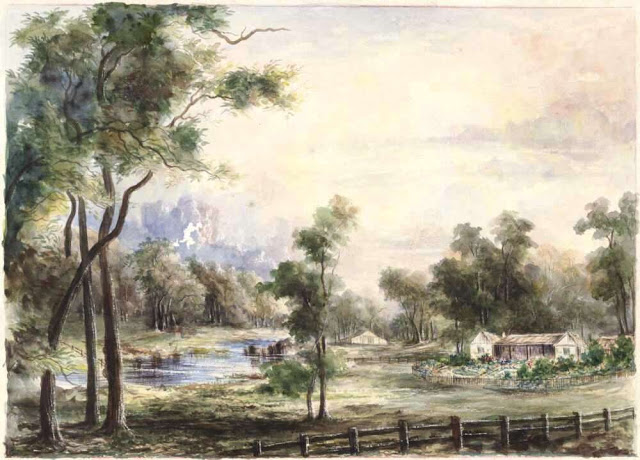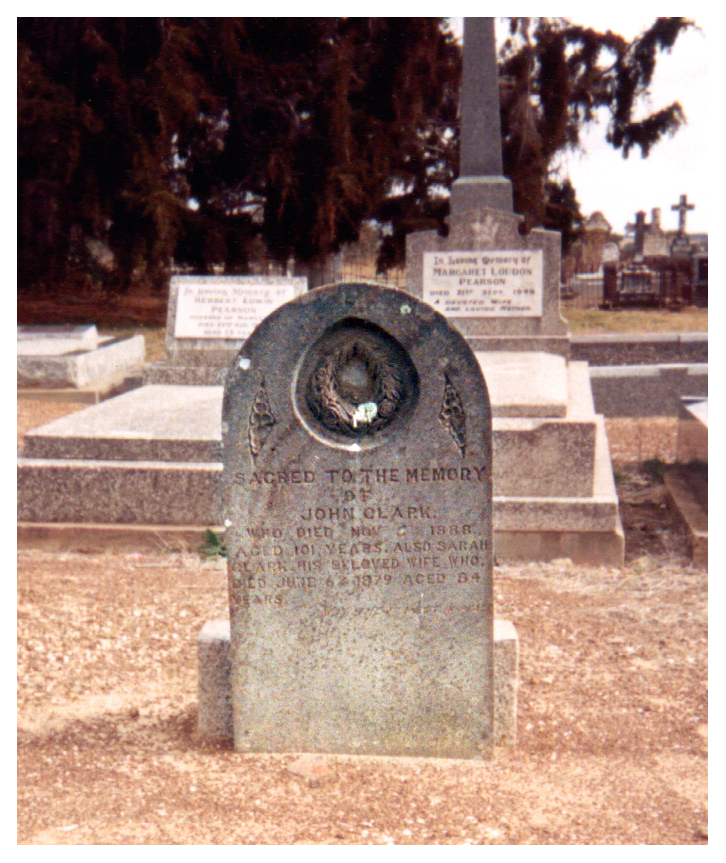
The Clark Family
Line of Descent
to
Helen Glenmire Davidson
Sarah & John Clark
▼
Jane Clark
▼
Sarah Farrell
▼
James "Harry" Davidson
▼
Helen Glenmire Davidson
return to the Davidson Family Tree
- Birth:
- c1790, Portglenone, County Antrim, Ireland
- Parents:
- William Clark and Matilda Orr
- Death:
- 6 November, 1888, Ollera, nr Guyra, NSW
- Birth:
- c1795, County Kerry, Ireland
- Parents:
- Henry Barclay and Jane Galloway
- Death:
- 5 June, 1879, Ollera, nr Guyra, NSW
- Marriage:
- 1824, Ireland
- Children:
- William (1824-1845)
- James (1827-bef.1879)
- Margaret (1830-1870)
- John (1832-1930)
- Jane (1834-1916)
- Sarah (1838-1845)
In the first half of the 19th century, the colonial government of New South Wales struggled to entice enough labourers to meet the demands of the growing colony, and brought in various schemes to encourage immigration, particularly from the British Isles, offering subsidised passage to workers and their families. Strict criteria was applied as to the suitability of each family, with character references required from local parish officials.
One of the families who responded in the hope of a better life was that of John and Sarah Clark, from Portglenone, in Antrim, Northern Ireland. John was a farm labourer, and he and Sarah had six children, who all came along on the voyage. The Herald left from Greenock, Scotland in October, 1844 and Cork, Ireland on 3 November - it's not known at which port the Clark family embarked. The notorious Potato Famine hadn't yet inflicted its scourge on the Irish at the time they left, but nevertheless, the Clarks obviously felt they would be better off in a new world.
Work on farms around the villages of Northern Ireland would not have prepared the family for the arduous voyage which took them south, or the family tragedy which came at the end of the voyage. Conditions on board ship obviously left much to be desired. Years later, the family's youngest son, John, retold the story of the voyage to New England newspaper, the Glen Innes Exmainer.
The trip out was an extremely rough and trying one, and two or three times, the passengers were "hatched down", so wild and stormy were the conditions.
After 90 days at sea, the Herald was nearing its final stop in Sydney when the Clark's eldest son, 20 year old William, died with a "stomach inflammation", according to the bald summary in the shipping records. Five days later, two days before the Herald berthed at Port Jackson, William's young sister, seven year old Sarah died of marasumus - severe malnutrition. So John and Sarah lost their first born and their youngest within a week.
Not all colonists welcomed the 200+ new arrivals. A writer in the Parramatta Chronicle writing about a voyage a year earlier by the same ship in January 1844 claimed it immigrants "had been greatly deceived by the immigration agents at home (i.e., Great Britain)" and that the passengers were "deluded" and were waiting at length for employment, and that the situation was worsened by the "destitution prevalent in Sydney and consequent on a want of employment for the labouring classes".
The situation does not appear to have improved greatly by the time of the Clark's voyage on the Herald a year later, when, in the Sydney Star, an article elaborated on what it said was "shiploads of useless people being foisted on us":
Of the number imported by the Herald, only sixty of whom are male adults, whose labour can be rendered available to any useful purpose; the remainder consisting of women and children, whose importation will only tend to augment the unproductive classes of the community, and increase the prevalent distress, which presses so heavy on the working classes, at the present time.
Bu t
the Clarks had employment waiting for them, which meant there was no
time for grieving the loss of William and Sarah.
t
the Clarks had employment waiting for them, which meant there was no
time for grieving the loss of William and Sarah.
The family was committed to join the workers of Andrew Wauchope, a partner in a property, Moredun on the far distant New England tablelands. After a week in Sydney, they boarded a coastal vessel for the trip to Port Macquarie, and then had to endure a six week arduous bullock team trip up the mountains to the New England area.
The Clark family stayed on Moredun for four years, followed by a brief period at Tenderden, before a final move to Tenderden's sister station, Ollera in 1852. (Within a year, the man who would become John and Sarah's son-in-law, Garrett Farrell, had also arrived at Ollera, becoming the property's premier bullock-driver)
left: Moredun station, c1848, by Edward Thomson
below: Ollera homestead, 1840.

The Clark famil y
became long-term workers and residents on Ollera, with
subsequent generations also staying to work as shepherds and
farmhands. The Clarks also worked assiduously at becoming partially
self supporting, requiring less rations from the station and even
selling produce back to the Ollera store. For example, the Ollera
records show that in 1857, the Clark family sold wheat worth £71.4s.0d
and '10 couple of fowls'. '*
y
became long-term workers and residents on Ollera, with
subsequent generations also staying to work as shepherds and
farmhands. The Clarks also worked assiduously at becoming partially
self supporting, requiring less rations from the station and even
selling produce back to the Ollera store. For example, the Ollera
records show that in 1857, the Clark family sold wheat worth £71.4s.0d
and '10 couple of fowls'. '*
John and Sarah's four children who survived the voyage to Australia had all accompanied them to the New England area... but the fortunes of their next eldest, James, are unknown, except that by the time of his mother Sarah's death in 1879, James had also died. A daughter, Margaret, who married Luke Cartan two years after the family's arrival in Australia, had also pre-deceased her mother, dying in 1870. So only two of the six Clark offspring lived to what could be described as "old age". John junior, who both worked at Ollera and led a rousabout life as occasional gold digger, shearer and teamster, eventually became a long-time resident of the nearby large town of Glen Innes, dying there in 1930, two years short of his century. John's younger sister Jane (Farrell) became a mainstay of the workers and their families on Ollera, eventually dying at Wandsworth, as the Ollera township became known, in 1916.
Sarah herself died in 1879, at the age of 84. John followed her in 1888, dying of what was described on his death certificate as "gradual decay". Both of these pioneers are buried in the private cemetery at Ollera Station (left), as is their daughter Jane, and son-in-law Garrett Farrell.